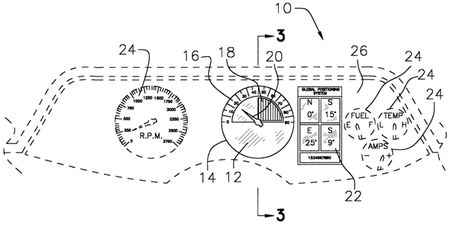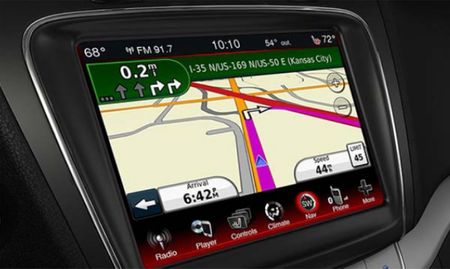Last week, the Patent Trial and Appeal Board ("PTAB" or "Board") issued the first inter partes review opinion in case IPR2012-00001, Garmin USA, Inc. (Petitioner) v. Cuozzo Speed Technologies LLC (Patent Owner). In what is being considered good news for parties wishing to challenge the validity of patents at the Office, the PTAB invalidated claims 10, 14, and 17 of Patent No. 6,778,074 ("Speed limit indicator and method for displaying speed and the relevant speed limit") as obvious in view of two different combinations of prior art. The Board also denied Cuozzo's motion to amend the claims. Even though the '074 patent does not deal with the Biotech or Pharmaceutical industry, the reasoning of the Board should be of interest to parties involved in all technologies.
As suggested by the title, the '074 patent relates to determining local speed limits, and it does so by using a Global Positioning System ("GPS"). Figure 1 from the patent is representative:
 The speedometer 12 is mounted on dashboard 26, and has a backplate 14 with speed markings, a color display 18 (described as red in the example), and a plastic needle 20 mounted on the backplate. The GPS receiver is able to track the location of the vehicle, and the speed limit indicator correlates the vehicle position with a database containing the speed limit for that location. The colored filter adjusts so that speeds above the legal speed are displayed in red, while legal speeds are displayed in white. Claim 10 reads as follows:
The speedometer 12 is mounted on dashboard 26, and has a backplate 14 with speed markings, a color display 18 (described as red in the example), and a plastic needle 20 mounted on the backplate. The GPS receiver is able to track the location of the vehicle, and the speed limit indicator correlates the vehicle position with a database containing the speed limit for that location. The colored filter adjusts so that speeds above the legal speed are displayed in red, while legal speeds are displayed in white. Claim 10 reads as follows:
10. A speed limit indicator comprising:
a global positioning system receiver;
a display controller connected to said global positioning system receiver, wherein said display controller adjusts a colored display in response to signals from said global positioning system receiver to continuously update the delineation of which speed readings are in violation of the speed limit at a vehicle's present location; and
a speedometer integrally attached to said colored display.
Cuozzo had asserted this claim against Garmin and Chrysler in the U.S. District Court for the District of New Jersey, alleging in part that "Garmin components in Chrysler's Uconnect system provide a display and warning indicating when the vehicle speed exceeds the speed limit." The following picture of the accused device was found in the Amended Complaint at paragraph 26, with the picture being credited to the Dodge website:
 Important in the Board's decision was the construction of the term "integrally attached." Of course, the PTAB does not use the same standard as a district court to construe issued claims -- the Board is required to use the broadest reasonable interpretation. The Board determined that "integrally attached" required that the speedometer and the colored display be separately identifiable from each other, otherwise "'attached' effectively would be read out of the claim." Therefore, the claim term was construed to mean "discrete parts physically joined together as a unit without each part losing its own separate identity." In so doing, it rejected Cuozzo's attempt to construe the term to mean that the two parts be joined or combined to work as a complete unit. Looking at the above picture, it would appear that Cuozzo was pressing for such a construction because it had its eye on the accused Garmin's product.
Important in the Board's decision was the construction of the term "integrally attached." Of course, the PTAB does not use the same standard as a district court to construe issued claims -- the Board is required to use the broadest reasonable interpretation. The Board determined that "integrally attached" required that the speedometer and the colored display be separately identifiable from each other, otherwise "'attached' effectively would be read out of the claim." Therefore, the claim term was construed to mean "discrete parts physically joined together as a unit without each part losing its own separate identity." In so doing, it rejected Cuozzo's attempt to construe the term to mean that the two parts be joined or combined to work as a complete unit. Looking at the above picture, it would appear that Cuozzo was pressing for such a construction because it had its eye on the accused Garmin's product.
The Board was also required to determine the date of Cuozzo's invention, because two of the prior art references qualified under 35 U.S.C. § 102(e)(2), and therefore Cuozzo could have antedated these references. The references in question had effective filing dates of October 19, 2000, and March 8, 2001. Cuozzo, the inventor, explained that he conceived his invention on November 28, 1999, when he was pulled over and ticketed for speeding. As he stated in his declaration:
I [Giuseppe A. Cuozzo] came up with the idea of using GPS technology combined with instrumentation for displaying a speed limit and its relation to vehicle speed in a manner that would alert a driver as to whether he or she was speeding without requiring the driver to refer to roadside speed limit signs.
However, even though he provided the speeding ticket as evidence, the Board did not consider this sufficient corroboration. Such a story can be invaluable when describing a case to a jury, but the Board was more skeptical. Part of the reason was that it could not see how the account provided for all of the limitations as found in the claims. Cuozzo also provided his written disclosure to the "Invention Submission Corporation" ("ISC"). Again, the Board found this document insufficient to corroborate the inventor's alleged date. The document had the hand-written date of October 30, 2000, which could not itself establish that it was prepared on that date. Instead, the Board afforded a date of conception of December 8, 2000, the date on which a patent attorney contacted Cuozzo describing the invention record. Nevertheless, the Board did not find that Cuozzo had acted diligently in reducing his invention to practice. There were two extended periods of little activity, which the Board found were not adequately explained. First, Cuozzo took about two months to respond to the attorney about a preliminary patentability report. In addition, Cuozzo took several months to get the required fee to the ISC. Cuozzo did not appear to be a sophisticated party with regard to the patent system, so such delays may well be understandable. However, the Board was not convinced, probably based in part on inconsistencies found in the inventor's testimony. As a result, the two cited art references were available for consideration in the obviousness determination.
Without going into a lot of technical detail regarding the obviousness analysis, both grounds involved one or two references that provided a way to display the vehicle speed with the maximum legal speed limit indicated in a single unit (not integrally attached). The first ground used one reference ("Aumayer"), which provided such an electronic embodiment (such as a liquid crystal display), in which the legal speed was obtained from an on-board GPS. The second ground used two references ("Tegethoff" and "Awada"), one which described the speedometer display, and the other which provided for reporting the legal speed limit. Because these references did not contain the "integrally attached" limitation, the Board also cited to "Evans," which provided for a permanent "indicator plate" that would alert the driver when a certain speed was reached (even though the speed could only be changed by manually changing the plate), and "Wendt," which provided a movable pointer that the driver could rotate himself when the speed limit changed. It was therefore possible to see how one skilled in the art could have derived the claimed invention. What appeared to be lacking from the decision was an explanation of why or how one skilled in the art would do so. Instead, the Board cited In re Kahn, 441 F.3d 977 (Fed. Cir. 2006) for the proposition that "[t]here only need be an articulated reasoning with rational underpinnings to support a motivation to combine teachings." Id. at 988. However, the Board's "articulated reasoning" was not very satisfying. The Board appeared to simply conclude that "[o]ne with ordinary skill in the art would have known to apply the same automated approach to the manually-adjusted colored plate suggested by Evans and Wendt." As further support, the Board noted that Cuozzo did not even argue that one of skill in the art would not have known how to implement this system. But, is this sufficient to show the requisite motivation to combine? One clear lesson for patent holders is that they will need to develop a strong case for all of the Graham factors when responding to an obviousness challenge before the Board.
Finally, the PTAB denied Cuozzo's attempt to amend the claims. For example, Cuozzo sought to amend claim 10 to add the limitation: "wherein the speedometer comprises a liquid crystal display, and wherein the colored display is the liquid crystal display." Cuozzo argued that these limitations simply incorporated limitations found in the dependent claims. However, the Board pointed out that such a limitation would read "integrally attached" out of the claims. Because a claim amendment in an inter partes review cannot enlarge the scope of claims or introduce new matter, the Board denied the motion. It does not appear that such an amendment would have had any impact on the validity ruling. Cuozzo was again probably seeking such a change because of the concurrent trial court action against Garmin.
This decision is important because the patent community is getting its first view at how the PTAB will be deciding these inter partes reviews. This decision should be good news for all of the parties challenging patents, and should be good news for everyone worried about the perceived patent-troll problem. The cost of an IPR proceeding, while not inexpensive, is likely to be much cheaper than a corresponding action in district court. Moreover, in case anyone was worried that the Board would rubber-stamp the original decision of the patent examiners, it is clear that patent owners could face significant challenges in defending their issued patents. It will be interesting to observe the trends as more of these decisions are issued.